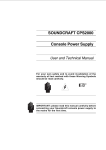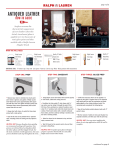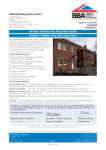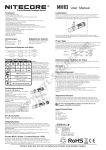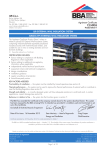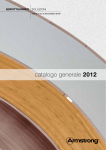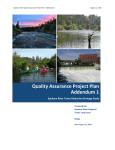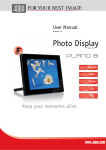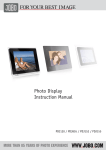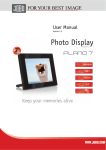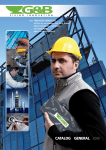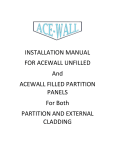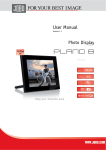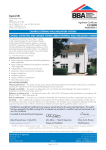Download ATLAS SP. Z O.O. ATLAS/AVAL EXTERNAL WALL INSULATION
Transcript
APPROVAL INSPECTION TESTING CERTIFICATION ATLAS SP. Z O.O. Sw. Teresy 105 91-222 Lodz (Łódź) Poland Tel: +48 631 88 00 / +48 631 89 55 Fax: +48/631 88 88 TECHNICAL APPROVALS FOR CONSTRUCTION Agrément Certificate 13/5018 e-mail: [email protected] website: www.atlas.com.pl Product Sheet 1 ATLAS/AVAL EXTERNAL WALL INSULATION SYSTEMS ATLAS/AVAL EPS EXTERNAL WALL INSULATION SYSTEMS This Agrément Certificate Product Sheet (1) relates to Atlas/Aval EPS External Wall Insulation Systems, comprising bonded and supplementary mechanicallyfixed enhanced expanded polystyrene (EPS) insulation boards with glassfibre mesh-reinforced render finishes, and suitable for use on new or existing domestic and non-domestic buildings up to 18 m in height. (1) Hereinafter referred to as ‘Certificate’. CERTIFICATION INCLUDES: • factors relating to additional non-regulatory information where applicable • independently verified technical specification • assessment criteria and technical investigations • design considerations • installation guidance • regular surveillance of production • formal three-yearly review. KEY FACTORS ASSESSED Thermal performance — the systems can be used to improve the thermal performance of external walls or contribute to meeting the requirements of the Building Regulations (see section 6). Strength and stability — correctly designed systems will have adequate resistance to wind loads and impact damage (see section 7). Behaviour in relation to fire — the expanded polystyrene is combustible but external surface rating classifications are B-s1, d0 or B-s2, d0, depending on the render finish (see section 8). Durability — when installed and maintained in accordance with the Certificate holder’s recommendations and the terms of this Certificate, the systems may be expected to have a life of at least 30 years (see section 13). The BBA has awarded this Certificate to the company named above for the systems described herein. These systems have been assessed by the BBA as being fit for their intended use provided they are installed, used and maintained as set out in this Certificate. On behalf of the British Board of Agrément Date of First issue: 1 July 2013 John Albon — Head of Approvals Claire Curtis-Thomas Energy and Ventilation Chief Executive The BBA is a UKAS accredited certification body — Number 113. The schedule of the current scope of accreditation for product certification is available in pdf format via the UKAS link on the BBA website at www.bbacerts.co.uk Readers are advised to check the validity and latest issue number of this Agrément Certificate by either referring to the BBA website or contacting the BBA direct. British Board of Agrément Bucknalls Lane Watford Herts WD25 9BA ©2013 Page 1 of 19 tel: 01923 665300 fax: 01923 665301 e-mail: [email protected] website: www.bbacerts.co.uk Regulations In the opinion of the BBA, Atlas/Aval EPS External Wall Insulation Systems, if installed, used and maintained in accordance with this Certificate, will meet or contribute to meeting the relevant requirements of the following Building Regulations (the presence of a UK map indicates that the subject is related to the Building Regulations in the region or regions of the UK depicted): The Building Regulations 2010 (England and Wales) (as amended) Requirement: A1 Loading Comment: Requirement: B4(1) External fire spread The systems can sustain and transmit wind loads to the substrate wall. See section 7.4 of this Certificate. Comment: The systems are classified Class B-s1, d0 or B-s2, d0 and, therefore, can meet this Requirement. See sections 8.1 to 8.4 and 8.7 of this Certificate. Requirement: C2(b) Resistance to moisture Comment: The systems provide a degree of protection against rain ingress. See sections 4.6 and 10.1 of this Certificate. Requirement: C2(c) Resistance to moisture Comment: The systems contribute to minimising the risk of interstitial and surface condensation. See sections 11.1, 11.2 and 11.4 of this Certificate. Requirement: L1(a)(i) Conservation of fuel and power Comment: Regulation: 7 Materials and workmanship Comment: Regulation: 26 CO2 emission rates for new buildings The systems can contribute to meeting this Requirement. See sections 6.2 and 6.3 of this Certificate. The systems are acceptable. See section 13.1 and the Installation part of this Certificate. The systems will enable, or contribute to enabling, a wall to meet the U value requirement. See sections 6.2 and 6.3 of this Certificate. Comment: The Building (Scotland) Regulations 2004 (as amended) Regulation: 8(1)(2) Fitness and durability of materials and workmanship The systems can contribute to a construction meeting this Regulation. See sections 12.1 and 13.1 and the Installation part of this Certificate. Comment: Regulation: Standard: 9 1.1 Building standards applicable to construction Structure Comment: Standard: 2.6 Spread to neighbouring buildings The systems can sustain and transmit wind loads to the substrate wall. See section 7.4 of this Certificate. The external surface of the systems have a ‘low risk’ surface spread of flame classification, with reference to clauses 2.6.1(1) (2), 2.6.2(1) (2), 2.6.4(1) (2), 2.6.5(1) and 2.6.6(2). See sections 8.1 to 8.3 and 8.5 to 8.7 of this Certificate. Comment: Standard: 2.7 Standard: 3.10 3.15 6.1(b) 6.2 7.1(a)(b) Comment: Statement of sustainability The systems can contribute to meeting the relevant requirements of Regulation 9, Standards 1 to 6, and therefore will contribute to a construction meeting the bronze level of sustainability as defined in this Standard. In addition the systems can contribute to a construction meeting a higher level of sustainability as defined in this Standard with reference to clause 7.1.4(1)(2) [Aspect 1(1)(2) and 2(1)], 7.1.6(1)(2) [Aspect 1(1)(2) and 2(1)] and 7.1.7(1)(2) [Aspect 1(1)(2) ]. See sections 6.2 and 6.3 of this Certificate. Comment: Regulation: Carbon dioxide emissions Building insulation envelope The systems can contribute to satisfying these Standards, with reference to clauses 6.1.1(1)(2), 6.1.2(1)(2), 6.1.3(1), 6.1.6(1), 6.2.10(2), 6.2.1(1)(2), 6.2.3(1), 6.2.4(2), 6.2.5(2), 6.2.6(1), 6.2.7(1), 6.2.8(2), 6.2.9(1)(2), 6.2.10(1), 6.2.11(1), 6.2.12(2) and 6.2.13(1)(2). See sections 6.2 and 6.3 of this Certificate. Comment: Standard: Condensation The systems can satisfy this Standard, with reference to clauses 3.15.1(1) (2), 3.15.4(1) (2) and 3.15.5(1) (2). See sections 11.3 and 11.4 of this Certificate. Comment: Standard: Standard: Precipitation The systems will contribute to a construction satisfying this Standard, with reference to clauses 3.10.1(1)(2) and 3.10.6(1)(2). See sections 4.6 and 10.1 of this Certificate. Comment: Standard: Spread on external walls The systems incorporate materials which would not be classed as ‘non-combustible’ as defined in this Standard, with reference to clauses 2.7.1(1)(2) and 2.7.2(2). See sections 8.1 to 8.3 and 8.5 to 8.7 of this Certificate. Comment: 12 Building standards applicable to conversions All comments given for the systems under Regulation 9, Standards 1 to 6, also apply to this Regulation, with reference to clause 0.12.1(1)(2) and Schedule 6(1)(2). (1) Technical Handbook (Domestic). (2) Technical Handbook (Non-Domestic). Page 2 of 19 The Building Regulations (Northern Ireland) 2012 Regulation: 23 Fitness of materials and workmanship Comment: Regulation: 28 Resistance to moisture and weather Comment: Regulation: 29 Condensation Comment: Regulation: 30 Stability Comment: Regulation: 36(a) External fire spread The systems are acceptable. See section 13.1 and the Installation part of this Certificate. The systems will satisfy this Regulation. See sections 4.6 and 10.1 of this Certificate. The systems can satisfy this Regulation. See sections 11.2 and 11.4 of this Certificate. The systems can sustain and transmit wind loads to the substrate wall. See section 7.4 of this Certificate. The systems have a Class B-s1, d0 or B-s2, d0 classification and can satisfy this Regulation. See sections 8.1 to 8.4 and 8.7 of this Certificate. Comment: Regulation: Regulation: 39(a)(i) 40 Comment: Conservation measures Target carbon dioxide emission rate The systems can contribute to satisfying these Regulations. See sections 6.2 and 6.3 of this Certificate. Construction (Design and Management) Regulations 2007 Construction (Design and Management) Regulations (Northern Ireland) 2007 Information in this Certificate may assist the client, CDM co-ordinator, designer and contractors to address their obligations under these Regulations. See section: 3 Delivery and site handling (3.1) of this Certificate. Additional Information NHBC Standards 2013 NHBC accepts the use of the Atlas/Aval EPS External Wall Insulation Systems, provided they are installed, used and maintained in accordance with this Certificate, in relation to NHBC Standards, Chapter 6.9 Curtain walling and cladding. Technical Specification 1 Description 1.1 This Certificate relates to Atlas/Aval EPS External Wall Insulation Systems, comprising enhanced expanded polystyrene (EPS) insulation boards adhesively fixed to the substrate wall, supplemented by mechanical fixings, and glassfibre reinforcing mesh with render finishes. 1.2 There are two system variants available, depending on the insulation product used in the installed systems. The systems (see Figure 1) comprise: Adhesive • ATLAS STOPTER K-10 (AVAL KT 83)/ATLAS STOPTER K-20 (AVAL KT 85)/ATLAS HOTER S (AVAL KT 53)/ATLAS HOTER U (AVAL KT 55) — cement based powder adhesives. Insulation • enhanced expanded polystyrene (EPS) insulation boards — 1200 mm by 600 mm in a range of thicknesses between 50 mm and 250 mm in 10 mm increments, with a nominal density of 16 kg·m–3 and a minimum compressive strength of 70 kN·m–2. Boards are manufactured to comply with the requirements of EPS 70 Class E (flame retardant) material to BS EN 13163 : 2012. Mechanical fixings • supplementary mechanical fixings — anchors of adequate length to suit the substrate and insulation thickness, approved and supplied by the Certificate holder and selected from: WKRĘT-MET- LFNØ8; WKRĘT-MET- LFMØ8; WKRĘT-MET- LTXØ8; WKRĘT-MET- LMXØ8; KOELNER KI-10; KOELNER KI-10M; KOELNER KI-10N; KOELNER KI-10NS; KOELNER TFIX-8S; KOELNER TFIX-8ST, or other anchors approved by the Certificate holder and covered by ETAs issued against the requirements of ETAG 014 : 2011. Basecoats • basecoats are available as follows: – ATLAS STOPTER K-20 (AVAL KT 85)/ATLAS HOTER U (AVAL KT 55) basecoat — cement-based powder adhesives applied to a thickness of 3 mm or greater. Double thickness of basecoat is required when a second layer of mesh is used – ATLAS CERPLAST (AVAL KT 16) — to be used with ATLAS CERMIT mineral (AVAL mineral) and ATLAS CERMIT acryl (AVAL acryl) finishing coats – ATLAS SILKAT ASX (AVAL KT 15) — to be used with ATLAS SILKAT (AVAL silicate) finishing coat – ATLAS SILKON ANX (AVAL KT 76) — to be used with ATLAS SILKON (AVAL silicone) finishing coat. Page 3 of 19 Reinforcement • the glassfibre reinforcing meshes: – SSA 1363 SM (100) mesh — alkali- and slide-resistant glassfibre mesh with a mesh size of 3.5 mm by 3.5 mm with a mass per unit area of 155 g·m2 – VERTEX 145A/AKE 145A/R 117 A 101 mesh — alkali- and slide-resistant glassfibre mesh with a mesh size of 3.5 mm by 4.0 mm with a mass per unit area of 150 g·m2. Primers • primers to be applied prior to rendering are available as follows: – ATLAS CERPLAST (AVAL KT 16) — to be used with ATLAS CERMIT mineral (AVAL mineral) and ATLAS CERMIT acryl (AVAL acryl) finishing coats – ATLAS SILKAT ASX (AVAL KT 15) — to be used with ATLAS SILKAT (AVAL silicate) finishing coat – ATLAS SILKON ANX (AVAL KT 76) — to be used with ATLAS SILKON (AVAL silicone) finishing coat. Finishing coats • finishing coats available as follows: – ATLAS CERMIT acryl (AVAL acryl) — ready to use paste (particle sizes of 1.5 mm, 2.0 mm and 3.0 mm) – ATLAS CERMIT mineral (AVAL mineral) — in powder form with particle sizes of 1.5 mm, 2.0 mm, 2.5 mm and 3.0 mm – ATLAS SILKAT (AVAL silicate) — ready to use paste (particle sizes of 1.5 mm and 2.0 mm) – ATLAS SILKON (AVAL silicone) — ready to use paste (particle sizes of 1.5 mm and 2.0 mm) • primers prior to optional coats are available as follows: – ATLAS ARKOL SX (AVAL KT 52) — to be used with ATLAS ARKOL S (AVAL KT 54) – ATLAS ARKOL NX (AVALKT 47) — to be used with ATLAS ARKOL N and ATLAS FASTEL – (AVAL KT 48 and AVAL KT 46) • optional finishing coats: – ATLAS ARKOL E (AVAL KT 44) — ready to use pigmented liquid – ATLAS ARKOL S (AVAL KT 54) — ready to use pigmented liquid – ATLAS ARKOL N (AVAL KT 48) — ready to use pigmented liquid – ATLAS FASTEL (AVAL KT 46) — ready to use pigmented liquid Ancillary materials/components (outside the scope of this Certificate) • a range of standard profiles for such details as wall base, end stop, corner mesh and expansion joint. Profiles are provided to the specifier’s requirements and approved by the Certificate holder • Sills — aluminium polyester coated sills or prefabricated/coated insulated window sills supplied by Certificate holder • fungicidal wash • sealant — silicone as approved by Certificate holder • polyurethane foam filler • stainless steel fire fixings • wall copings — aluminium polyester powder coated copings • below damp-proof course (dpc) insulation. Page 4 of 19 Figure 1 Atlas/Aval EPS External Wall Insulation Systems continuous ribbon of adhesive around circumference of EPS substrate suitably prepared substrate EPS insulation basecoat mechanical fixing primer coat glassfibre mesh finish coat plinth strip starter track PVC corner bead with integral mesh wings 1.3 The insulation boards are primarily bonded and supplementary mechanically fixed to the external surfaces of walls on new or existing vertical building walls made of masonry or concrete. The adhesive coat should be at least 40% of the bonded area and supplementary mechanical fixings should be at an average frequency of four to five fixings per square metre, using the fixing pattern illustrated in Figure 6. When all the boards have been secured to the wall, the basecoat is trowel-applied to the insulation boards to a minimum thickness of 3 mm. The reinforcing mesh is embedded into the basecoat and additional basecoat applied as required and when a second layer of mesh is included. The systems are finished with a layer of render finish coat and optional decorative coats. 2 Manufacture 2.1 As part of the assessment and ongoing surveillance of product quality, the BBA has: • • • • • • agreed with the manufacturer the quality control procedures and product testing to be undertaken assessed and agreed the quality control operated over batches of incoming materials monitored the production process and verified that it is in accordance with the documented process evaluated the process for management of nonconformities checked that equipment has been properly tested and calibrated undertaken to carry out the above measures on a regular basis through a surveillance process, to verify that the specifications and quality control operated by the manufacturer are being maintained. 2.3 The management system of ATLAS SP. Z O.O. has been assessed and registered as meeting the requirements of BS EN ISO 9001 : 2008 by DQS GmbH (Certificate 062002 QM08/UM). 3 Delivery and site handling 3.1 Each package carries the product identification, manufacturer’s batch number and the BBA logo incorporating the number of this Certificate. The components are delivered to site in the packaging and quantities listed in Table 1. Table 1 Component supply details Component Quantity and package Insulations boards Shrink-wrapped in polythene Basecoat render 25 kg bag Mechanical fixings boxed by manufacturer Reinforcement mesh 1 m x 50 m rolls Primer 25 kg tubs Finishing coats – renders 25 kg tubs 3.2 Insulation should be stored off the ground on a firm, clean, dry and level base. The insulation should be protected from prolonged exposure to sunlight by storing opened packs under cover in dry conditions or by re-covering with opaque polythene sheeting. The boards should not be exposed to open flame or other ignition sources. 3.3 Care must be taken when handling the insulation boards to avoid damage and contact with solvents or materials containing volatile organic components. Page 5 of 19 3.4 Each container for other components, eg mesh cloth, primers, renders, bears the manufacturer’s and product’s identification marks, batch number and the BBA logo incorporating the Certificate number. These components must be stored in accordance with the manufacturer’s instructions, in dry conditions, and at the manufacturer’s recommended temperatures. They should be used within the stated shelf life, where applicable. 3.5 The renders are cementitious materials and should be stored in dry conditions, off the ground, and protected from frost at all times. Damaged, wet or contaminated products should not be used and must be discarded. Assessment and Technical Investigations The following is a summary of the assessment and technical investigations carried out on the Atlas/Aval EPS External Wall Insulation Systems. Design Considerations 4 General 4.1 The Atlas/Aval EPS External Wall Insulation Systems, when installed in accordance with this Certificate, are effective in reducing the thermal transmittance (U value) of external masonry walls in new and existing buildings. 4.2 The systems are applied to the outside of external walls of masonry and dense or no-fines concrete construction and are suitable for use on new or existing domestic or non-domestic buildings up to 18 m in height. Application and maintenance must be carried out strictly in accordance with this Certificate and the Certificate holder’s instructions, by installers trained and approved by the Certificate holder. 4.3 It is essential that the detailing techniques specified in this Certificate are carried out to a high standard, if the ingress of water into the insulation is to be avoided and the full thermal benefit obtained from the systems. Only details approved by the Certificate holder should be specified and used. 4.4 The systems can improve the weather resistance of a wall and provide a decorative finish. However, they may only be installed where other potential sources of moisture penetration have been dealt with separately and where there are no signs of dampness on the inner surface of the wall, other than those caused solely by condensation. The systems can be used to overcome internal condensation. 4.5 Existing buildings subject to national Building Regulations should have wall surfaces in accordance with section 14 of this Certificate. 4.6 New buildings subject to national Building Regulations should be constructed in accordance with the relevant recommendations of: • BS EN 1996-2 : 2006 and its UK National Annex — the designer should select a construction appropriate to the local wind-driven rain index, paying due regard to the design detailing, workmanship and materials to be used • BS 8000-3 : 2001. 4.7 Other new buildings, not subject to any of the previous requirements, should also be built in accordance with BS EN 1996-2 : 2006 and its UK National Annex. 4.8 The effect of the installation of the systems on the acoustic performance of a construction is outside the scope of this Certificate. 4.9 The fixing of rainwater goods, satellite dishes, clothes lines, hanging baskets and similar items is outside the scope of this Certificate. 4.10 It is essential that the system is installed and maintained in accordance with the conditions set out in this Certificate. 5 Practicability of installation The systems should be installed only by specialised contractors who have successfully undergone training and registration by the Certificate holder. Note: The BBA operates a UKAS Accredited Approved Installer Scheme for external wall insulation; details of approved installer companies are included on the BBA’s website (www.bbacerts.co.uk). 6 Thermal performance 6.1 Calculations of thermal transmittance (U value) should be carried out in accordance with BS EN ISO 6946 : 2007 and BRE Report BR 443 : 2006, using the insulation manufacturer’s declared thermal conductivity (90/90 value) of 0.031 W·m–1·K–1. 6.2 The U value of a completed wall will depend on the insulation thickness, type of fixings and the insulating value of the substrate masonry and its internal finish. Figures for typical design U values, calculated in accordance with section 6.1, are given in Table 1. Page 6 of 19 Table 1 Insulation thickness required to achieve some typical design values(1)(2) Insulation thickness requirement (mm) U-value (W·m-2·K-1) Brickwork, = 0.56 W·m-1·K-1 Dense blockwork, = 1.75 W·m-1·K-1 0.19 160 180 0.26 110 120 0.28 100 110 0.30 90 100 0.35 80 85 (1) The following values for other elements of the construction were used: external boundary resistance (Rse) — 0.04 m2·K·W–1 render (14 mm sand and cement) — = 1.0 W·m–1·K–1, µ = 6 (wet) 215 mm brickwork (protected) (= 0.56 W·m–1·K–1, µ = 10) or 200 mm blockwork ( 6.7% mortar — = 0.88 W·m = 1.75 W·m–1·K–1, µ = 100) ·K –1 –1 plaster (13 mm) — = 0.57 W·m–1·K–1, µ = 10 internal boundary resistance (Rsi) — 0.13 m2·K·W–1. (2) Fixing regime 4 fixings per m2 with a point thermal transmittance = 0.003 W·K–1. (3) Based upon incremental insulation thickness of 10 mm. 6.3 The system can maintain, or contribute to maintaining, continuity of thermal insulation (see Figure 2). Care must be taken to ensure an appropriate thickness of insulation is used, particularly at points such as junctions between floors and walls and at window and door reveals, to avoid thermal bridging and reduce the risk of condensation forming at these points. Items such as windows and doors should be selected to take into account the thickness of insulation required at the reveals to help prevent condensation forming at these junctions. Detailed guidance for junctions and on limiting heat loss by air infiltration can be found in: England and Wales — Approved Documents to Part L and, for new thermal elements to existing buildings, Accredited Construction Details (version 1.0) (for new-build, see also SAP 2009, Appendix K, and the iSBEM User Manual) Scotland — Accredited Construction Details (Scotland) Northern Ireland — Accredited Construction Details (version 1.0). Figure 2 Junction detail attic insulation insulation mechanical fixing render Page 7 of 19 7 Strength and stability 7.1 When installed on masonry or concrete walls, the system can adequately transfer to the wall the self-weight and negative (suction) and positive (pressure) wind loads normally experienced in the United Kingdom. 7.2 Positive wind load (pressure) is transferred to the substrate wall directly via bearing and compression of the render, adhesive and insulation. 7.3 Negative wind pressure (suction) is resisted by the bond between each component. The insulation boards are retained by the external wall insulation systems adhesive and supplementary anchors. 7.4 The wind loads on the wall should be calculated in accordance with BS EN 1991-1-4: 2005. Special consideration should be given to locations with high wind-load pressure coefficients as additional fixings may be necessary. In accordance with BS EN 1990 : 2002, it is recommended that a load factor of 1.5 is used to determine the ultimate wind load to be resisted by the systems. 7.5 Calculations to determine resistance to negative wind loads should be based on bond strength between insulation and adhesive as 30 kN·m-2. With a minimum of 40% bonded area and a safety factor of 9, the design resistance to bond failure may be taken as 1.33 kN·m-2. 7.6 Assessment of structural performance for individual buildings must be carried out by a suitably qualified and experienced individual to confirm that: • the substrate wall has adequate strength to resist the additional loads that may be applied as a result of installing the systems, ignoring any positive contribution that may occur from the insulation systems • the proposed systems with associated supplementary fixing layout provide adequate resistance to negative wind loads. After the adhesive is set, the associated bond strength between adhesive and substrate provides adequate resistance to negative wind loads • an appropriate number of site-specific pull-off tests are conducted on the substrate of the building to determine the minimum resistance to failure of the bond strength. The bond strength between the adhesive and the substrate should be determined on site and taken as the lowest of the five results divided by a safety factor of 9 and multiplied by the minimum bond area of 40%(1). (1) If this value is less than the ultimate wind load, the bonded area should be increased. 7.7 The number of supplementary fixings and the span between fixings should be determined by the system’s designer. Provided the substrate wall is suitable and an appropriate fixing is used, the mechanical fixings will initially transfer the weight of the systems to the substrate wall. The fixing must be selected to give adequate support to the weight of the systems at the minimum spacing. 7.8 Typical characteristic pull-out strengths for the supplementary fixings can be taken from the corresponding European Technical Approval (ETA); however, these values are dependent on the substrate and the fixings must be selected to suit the initial loads and substrate concerned. Impact loading 7.9 Hard body impact tests were carried out in accordance with ETAG 004 : 2011. The systems are suitable for use in the categories listed in Table 2 (see section 7.10). Page 8 of 19 Table 2 Atlas/Aval EPS Systems impact resistance Rendering systems: insulation, basecoat, key coat with finishing coat indicated EPS + basecoat ATLAS STOPTER K-20/AVAL KT 85(2) Finishing coat Impact resistance using glassfibre mesh(1) ATLAS CERMIT mineral/AVAL mineral Category III ATLAS CERMIT acryl/AVAL acryl(3) Category II ATLAS SILKAT/AVAL silicate Category III ATLAS SILKON/AVAL silicone(4) Category II ATLAS CERMIT mineral/AVAL mineral Category III ATLAS CERMIT acryl/AVAL acryl(4) Category II ATLAS SILKAT/AVAL silicate Category II ATLAS SILKON/AVAL silicone(4) Category II ATLAS CERMIT acryl/AVAL acryl Category II ATLAS SILKON/AVAL silicone Category II (4) (4) EPS + basecoat ATLAS HOTER U/AVAL KT 55(2) ATLAS SILKAT/AVAL silicate Category II ATLAS CERMIT acryl/AVAL acryl Category II ATLAS SILKAT/AVAL silicate Category II ATLAS SILKON/AVAL silicone Category II (1) Single layer of glassfibre mesh SSA 1363 SM (100). Weight 155 g·m . (2) With relevant basecoat according to section 1.2. (3) Double layer of SSA 1363 glassfibre mesh provides a Category I impact resistance on ATLAS STOPTER K-20/AVAL KT-85 adhesive + priming mass ATLAS CERPLAST/AVAL KT-16 + acrylic render ATLAS CERMIT/AVAL acrylic. (4) Double layer of SSA 1363 glassfibre mesh provides a Category II Impact Resistance on applicable systems including ATLAS STOPTER K-20/AVAL KT 85 basecoat with ATLAS SILKAT/AVAL silicate finishing coat. -2 7.10 These use categories are defined in ETAG 004 : 2011 as: • Category I – a zone readily accessible at ground level to the public and vulnerable to hard body impacts but not subjected to abnormally rough use • Category II – a zone liable to impacts from thrown or kicked objects, but in public locations where the height of the system will limit the size of the impact; or at lower levels where access to the building is primarily to those with some incentive to exercise care • Category III – a zone not likely to be damaged by normal impacts caused by people or by thrown or kicked objects. 8 Behaviour in relation to fire General 8.1 The overall spread of flame classification for the rendering systems in accordance with BS EN 13501-1 : 2007, is as follows: Table 3 Reaction to fire classification Rendering Systems Above dpc adhesive, base and finishing coats (shown in section 1.2) with any compatible primer, as indicated in this Certificate Reaction to fire class Atlas/Aval EPS External Wall Insulation Systems, with mineral/inorganic based rendering systems: • adhesive — STOPTER K10 (AVAL KT 83), STOPTER K20 (AVAL KT 85), HOTER U (AVAL KT 55), HOTER S (AVAL KT 53) • base coats — STOPTER K20 (AVAL KT 85), HOTER U, (AVAL KT 55) • finishing coats — Mineral finishes CERMIT/AVAL KT 137, AVAL KT 35, (with key coat CERPLAST/AVAL KT 16) or silicate finishes SILKAT/AVAL KT 72, AVAL KT 73 (with key coat SILKAT ASX/AVAL KT 15) • decorative coats — ARKOL E/AVAL KT 44, ARKOL S/AVAL KT 54 (with primer ARKOL SX/AVAL KT 52), ARKOL N/AVAL KT 48, (with primer ARKOL NX/AVAL KT 47), FASTEL NOVA/AVAL KT 46 (with primer ARKOL NX/AVAL KT 47) B-s1, d0 ATLAS/ AVAL EPS External Wall Insulation Systems, with organic based rendering systems: • adhesives — STOPTER K10 (AVAL KT 83), STOPTER K20 (AVAL KT 85), HOTER U (AVAL KT 55), HOTER S (AVAL KT 53) • basecoats — STOPTER K20 (AVAL KT 85), HOTER U, (AVAL KT 55) • finishing coats — acrylic finishes CERMIT/AVAL KT 60, AVAL KT 64, (with key coat CERPLAST/AVAL KT 16) or silicone finish SILKON/AVAL KT 74 , AVAL KT 75 (with key coat SILKON ANX/AVAL KT 76) • decorative coats — ARKOL E /AVAL KT 44, ARKOL N /AVAL KT 48, FASTEL NOVA AVAL KT 46 (with relevant primers) B-s2, d0 Page 9 of 19 8.2 The fire classifications apply to the full range of thicknesses covered by the Certificate (see section 1.2). 8.3 The enhanced EPS insulation material in isolation is not classified as 'non-combustible'. 8.4 the systems are considered suitable for use on or at any distance from the boundary and are restricted for use in buildings less than 18 m in height. 8.5 the systems are classified as ‘low risk’ combustible materials and must not be used within 1 m of the boundary. They are restricted for use in buildings less than 18 m in height. 8.6 The systems are not classified as ‘non-combustible'; therefore, calculations for unprotected areas apply with some minor exceptions. 8.7 Application to second storey walls and above should include at least one stainless steel mechanical fixing per square metre and fire barriers in line with compartment walls and floors (see Figure 3). For installation of fire barriers and steel fixings refer to the guidance in BRE Report BR 135. Figure 3 Fire barrier substrate 2nd floor mechanical fixing inside fire barrier stone mineral wool stainless steel fire rated mechanical fixing insulation 1st floor 9 Proximity of flues and appliances When the systems are installed in close proximity to certain flue pipes, the relevant provisions of the national Building Regulations should be met: England and Wales — Approved Document J Scotland — Mandatory Standard 3.19, clause 3.19.4(1)(2) (1) Technical Handbook (Domestic). (2) Technical Handbook (Non-Domestic). Northern Ireland — Technical Booklet L. 10 Weathertightness 10.1 The systems will provide a degree of protection against rain ingress. However, care should be taken to ensure that walls are adequately weather tight prior to the application of the insulation systems. The insulation systems may only be installed where there are no signs of dampness on the inner surface of the substrate other than those caused solely by condensation. 10.2 Designers and installers should take particular care in detailing around openings, penetrations and movement joints to minimise the risk of rain ingress. 10.3 Guidance given in BRE Report BR 262 : 2002 should be followed in connection with the weathertightness of solid wall constructions. The designer should select a construction appropriate to the local wind-driven rain index, paying due regard to the design detailing, workmanship and materials to be used. 10.4 At the tops of walls, the systems should be protected by an adequate overhang or other detail designed for use with these types of systems. Page 10 of 19 11 Risk of condensation 11.1 Designers must ensure that an appropriate condensation risk analysis has been carried out for all parts of construction, including openings and penetrations at junctions between the insulation systems, to minimise the risk of condensation. The recommendations of BS 5250 : 2011 should be followed. Surface condensation 11.2 Walls will adequately limit the risk of surface condensation when the thermal transmittance (U value) does not exceed 0.7 W·m–2·K–1 at any point and the junctions with other elements and openings comply with section 6.3. 11.3 Walls will adequately limit the risk of surface condensation when the thermal transmittance (U value) does not exceed 1.2 W·m–2·K–1 at any point. Guidance may be obtained from BS 5250 : 2011 (Section 8, Annex D) and BRE Report BR 262 : 2002. Interstitial condensation 11.4 Walls incorporating the systems will adequately limit the risk of interstitial condensation when they are designed and constructed in accordance with this Certificate. 11.5 The render systems used with the systems have an equivalent air layer of thickness (Sd) of 2, 0 m. This corresponds to a water vapour resistance factor (µ) which is dependent on the particular basecoat and finish configuration as stated in ETA 06/0081. 11.6 The water vapour resistance factors (µ) for the EPS is 60, as taken from BS EN ISO 10456 : 2007, Table 4. 12 Maintenance and repair 12.1 Regular checks should be made on the installed system, including: • visual inspection of the render for signs of damage. Cracks in the render exceeding 0.2 mm must be repaired • examination of the sealant around openings and service entry points • visual inspection of architectural details designed to shed water to confirm that they are performing properly • visual inspection to ensure that water is not leaking from external downpipes or gutters; such leakage could penetrate the rendering • necessary repairs effected immediately and the sealant joints at window and door frames replaced at regular intervals • maintenance schedules, which should include the replacement and resealing of joints, for example between the insulation systems and window and door frame. 12.2 The designer should ensure suitable access is available to enable maintenance inspections to take place safely. 12.3 Damaged areas must be repaired using the appropriate components and the procedures detailed in the Certificate holder’s installation instructions. 13 Durability 13.1 The systems will remain effective for at least 30 years, provided any damage to the surface finish is repaired immediately and regular maintenance is undertaken as described in section 12. To maintain the aesthetic appearance where decorative coats are used, it may be necessary to overcoat the installation at regular intervals. 13.2 Any render containing Portland cement may be subject to lime bloom. The occurrence of this may be reduced by avoiding application in adverse weather conditions. The effect is transient and is less noticeable on lighter colours. 13.3 The render may become discoloured with time, the rate depending on the initial colour, the degree of exposure and atmospheric pollution, as well as the design and detailing of the wall. In common with traditional renders, discoloration by algae and lichens may occur in wet areas. The appearance may be restored by a suitable power wash or, if required, by over coating. Installation 14 Site survey and preliminary work 14.1 A pre-installation survey of the property is carried out to determine suitability for treatment and the need for any necessary repairs to the building structure before application of the Atlas/Aval EPS External Wall Insulation Systems. A project specific design specification is prepared for each elevation of the building indicating: • • • • • the position of beads detailing around windows, doors and at eaves dpc level exact position of expansion joints where required, additional corner mesh and reinforcement Page 11 of 19 • areas where flexible sealants must be used • any alterations to external plumbing • where required, the position of fire barriers. 14.2 The survey should include tests conducted on the walls of the building by the Certificate holder/Technical Distributor or their approved applicators (see section 15) to determine the pull-off resistance of the proposed adhesive and pull-out tests for supplementary mechanical fixings for the appropriate substrate. An assessment and recommendation is made on the percentage of the adhesive coverage per board (minimum 40%) required to withstand the building’s expected wind loading, based on calculations using the fixing’s pull-off resistance test data. In addition, the type and number of supplementary fixings are selected (see section 7). The advice of the Certificate holder/ Technical Distributor should be sought to ensure the proposed bonding pattern is sufficient. 14.3 Surfaces should be sound, clean and free from loose material. The flatness of surfaces must be checked; this may be achieved using a straight edge spanning the storey height. Any excessive irregularities, ie greater than 10 mm in one metre, must be made good prior to installation to ensure that the insulation boards are installed with a smooth, in-plane finished surface. 14.4 On existing buildings, purpose-made window sills must be fitted to extend beyond the finished face of the systems. New buildings should incorporate suitably deep sills. 14.5 Where surfaces are covered with an existing rendering, it is essential that the bond between the background and the render is adequate. All loose areas should be hacked off and reinstated. For further guidance, reference should be made to BS 13914-1 : 2005. 14.6 Internal wet work, eg screed or plastering, should be completed and allowed to dry prior to the application of a system. 14.7 All modifications, such as provision for cavity barriers and fire stopping (see section 8) and necessary repairs to the building structure, are completed before installation commences. 15 Approved installers Application of the systems, within the context of this Certificate, is carried out by approved installers recommended or recognised by the Certificate holder. Such an installer is a company: • employing operatives who have been trained and approved by the Certificate holder to install the systems • which has undertaken to comply with the Certificate holder’s application procedures, containing the requirement for each application team to include at least one operative trained by the Certificate holder • subject to at least one inspection per annum by the Certificate holder to ensure that suitable site practices are being employed. This may include unannounced site inspections. 16 Procedure General 16.1 Installation is carried out in accordance with the current installation instructions of the Certificate holder. 16.2 Following the award of a contract, the site specific pack is prepared by one of the ATLAS/AVAL appointed Technical Distributors (TDs) based on the information recorded in the site survey form. 16.3 The substrate is prepared in accordance with the project specific site package. This will include brushing down walls, washing with clean water and treatment with a fungicidal wash as required. 16.4 Weather conditions must be monitored to ensure correct application and curing conditions. Renders must not be applied if the temperature is below 5°C or above 25°C at the time of application. In addition, cementitious-based renders must not be applied if the temperature will be below 0°C at any time during the 72 hours after application, and cement-free, synthetic-resin, silicone-resin and silicate renders must not be applied if the temperature will be below 5°C at any time during the 72 hours after application. ATLAS Stopter K20 (AVAL KT 85) adhesive mortar can be applied in temperature between 0°C and 5°C, provided temperatures do not fall below –5°C for 8 hours after completion. The ATLAS/AVAL Code of Practice should be referenced regarding all temperature/humidity restrictions that apply. Until fully cured, the coatings must be protected from rapid drying, precipitation, direct sunlight and strong wind. 16.5 All rendering should be in accordance with BS EN 13914-1 : 2005. 16.6 Refer to the site PSD (Project Specific Design) package for guidance on modifications of down pipes, soil and vent pipes, pipe extensions etc. Where possible, all pipe work should be relocated as required to accommodate the insulation. Where pipe work cannot be re-located and is to be housed in the depth of the systems, access for maintenance must be maintained through the use of removable covers or alternative design to be approved by the Certificate holder. This is outside the scope of this Certificate. Positioning and securing insulation boards 16.7 The base profile is secured to the external wall above the dpc using approved profile fixings at 300 mm maximum centres (see Figure 3). Beads and expansion joints are incorporated as specified. Page 12 of 19 16.8 Skirting boards are then fixed to the wall below the dpc to provide necessary impact and capillary action resistance. To minimise cold bridging, high density EPS insulation should be extended below the ground level where practicable and economically viable. Where this is not possible, the first run of high density EPS boards should be positioned at ground level or, in the case of the High Density EPS Hydroboard, 10 mm minimum above ground level (as shown in Figure 4). This is outside the scope of this Certificate. Figure 4 Typical section at base level render finish insulation mechanical fixing substrate base bead work below base bead is outside of the scope of this Certificate 16.9 The insulation boards are bonded to the wall by applying the specified adhesive to the boards using the “strip-point” method. A circumferential ribbon of adhesive at least 30 mm wide is applied to the insulation boards. Six to eight evenly distributed patches of adhesive, 80 to 120 mm in diameter, are then applied to the boards so that an adhesive surface of at least 40% is achieved (60% after application and pressing) (see Figure 5). Alternatively, for even and smooth substrates, the whole panel can be coated with adhesive using a notched trowel to produce a coat 2 to 5 mm in thickness. The insulation panel should be immediately placed on the substrate and pressed into place. Figure 5 Insulation board adhesive application adhesive (> 40% of insulation board) insulation Page 13 of 19 16.10 Subsequent rows of insulation boards are installed above the dpc, on top of the starter track and positioned so that the vertical board joints are staggered and overlapped at the building corners (see Figure 6). Figure 6 Insulation boards and fixing layout detail insulation board mechanical fixings reinforcing mesh strip 16.11 A minimum of four or five mechanical fixings per m2 for insulation boards should be installed unless otherwise specified in the project specific design (see Figure 6). 16.12 Details of supplementary mechanical fixings (including their arrangement in the insulation boards) are specified in the project specific design requirements, based on pull-out test results, substrate type and wind loading data. Installation of mechanical fasteners shall commence no earlier than 24 hours after the insulation panels have been adhesively fixed. 16.13 There should be at least one stainless steel fire fixing per square metre, starting from the second storey (see section 8.7). 16.14 To avoid thermal bridging ensure a tight, adhesive free, joint connection. Foam filler approved by the Certificate Holder may be used for filling gaps up to 5 mm. When used, the expanding foam should have a fire-rating of B2 or better and a maximum value of 0.035 W·m-2·k-1. Larger gaps should be filled with strips of the insulation material. 16.15 At façade openings eg windows and doors, insulation boards must not be continued around the corner. Insulation boards must overlap at these locations and can be cut to size to facilitate this. Any projecting EPS boards should be levelled out using a rubbing board with local trimming as required on mineral wool boards. 16.16 Window and door reveals should be insulated to minimise the effects of a cold bridging in accordance with the recommendations of the Accredited Construction Details. Where clearance is limited, strips of approved insulation should be installed to suit available margins and details. 16.17 Building corners, door and window heads and jambs are formed using angle beads bonded to the insulation in accordance with the manufacturer’s instructions. 16.18 Purpose-made and ATLAS approved powder-coated galvanized stainless steel or aluminium window sills (complete with PVC sill end caps) or a purpose made prefabricated pre-coated insulated over sill are installed in accordance with the Certificate holders instructions. They are designed to prevent water ingress and incorporate drips to shed water clear of the systems (see Figures 7 to 9). Page 14 of 19 Figure 7 Window sill and reveal detail corner bead insulation oversill reveal insulation interior window sill interior wall PVC frame Figure 8 Window sill detail — metal or pvc sill reveal PVC or zinc powder coated sill with endcaps or upstands compression seal strip original concrete sill insulation original plaster Page 15 of 19 Figure 9 Pre-fabricated insulated sill (eco-oversill) reveal poly sealant 5-10 mm adhesive Eco oversill original concrete sill insulation 16.19 Lamella (Rockwool) fire barriers are installed in accordance with the certificate holder's instructions (see section 8.7 of this Certificate), at locations defined in the project specific site package (see Figure 3). 16.20 For EPS insulation, any high spots or irregularities should be removed by lightly planning with a rasp to ensure the application of an even thickness of basecoat. After sufficient stabilisation of the installed insulation (normally 2 days, during which time the insulation should be protected from exposure to extreme weather conditions to prevent degradation), the insulated wall is ready for the application of the base and finish coats. 16.21 EPS boards exposed to UV light for extended periods prior to the application of the render coatings are subject to breakdown and should be rasped down as required in preparation for rendering. Movement joints and render beads 16.22 Movement joints in the substrate must be continued through the systems. This may necessitate the use of backto-back full systems stop beads with a sealant and backer strip depending on the width of the joint and the degree of movement anticipated. Additional expansion joints in the insulation systems are determined by the Certificate holder at the time of the initial survey. Each project is considered on its own merits and the Certificate holder will take into account construction format, building design and fenestration when determining the regularity and positioning of both vertical and horizontal expansion joints in the systems (see Figure 10). Page 16 of 19 Figure 10 Expansion joint expansion joint substrate insulation strip of insulation reinforcing mesh straight expansion joint profile render 16.23 At all locations where there is a risk of insulant exposure, eg window reveals or eaves, the system must be protected eg by an adequate overhang or by purpose made sub-sills, seals or flashing (see Figure 1). Reinforcing 16.24 The basecoat is prepared and is trowel applied to the surface of dry insulation boards at approximately two thirds of the final basecoat thickness. Basecoats requiring the addition of water should be mixed mechanically using a drill and mixer. 16.25 A 10 mm toothed trowel (held at 45° to the insulation board) is used to leave castellations in the basecoat. A layer of alkali-resisting glassfibre mesh is then applied either vertically or horizontally ensuring the mesh is overlapped at joints by a minimum of 100 mm (overlaps in quoins should be a minimum of 150 mm). The mesh should be pressed into the basecoat using a notched float so that it is not visible, taking care that it does not make direct contact with the insulation. 16.26 The remaining one third thickness of basecoat is then applied as required to ensure the mesh is completely covered and the required minimum thickness of basecoat is achieved. Where a second layer of mesh is required to achieve the required impact resistance, application of the basecoat and mesh layers should be performed in two operations. After a minimum of 24 hours, a second layer of basecoat and mesh is applied to provide a combined total basecoat thickness of approximately 8 mm. 16.27 Additional pieces of reinforcing mesh (approximately 300 mm by 200 mm strips) are applied diagonally at a 45° angle, prior to the second application of the basecoat to provide the necessary reinforcement in the corners of window/door openings in accordance with the Certificate holder’s instructions (see Figure 6). Rendering and finishing 16.28 The basecoat must be allowed to dry/cure for approximately three days prior to the application of the primer/ finish coat. Sealant should be applied prior to the application of the finishing coat as defined in the project specific site package and in accordance with the Certificate holder’s instructions. 16.29 Primers should be applied in accordance with the Certificate holder’s instructions and allowed to dry for approximately 12 hours before the application of the finishing coat is commenced. 16.30 Finishing coats should be applied in accordance with the Certificate holder’s instructions. 16.31 It is imperative that weather conditions are suitable for the application and to allow curing of the ATLAS/ AVAL finishing coats. These should not be applied when the air or wall temperature is below +5°C or above 25°C for the duration of the curing time. In wet weather the finished walls should be protected to prevent wash-off. It is also advisable that protective covers remain in place as required to maximise the drying process. 16.32 In sunny weather, work should commence on the shady side of the building and be continued to follow the sun, to prevent the rendering drying out too rapidly. 16.33 To minimise colour shade variations and to avoid dry line jointing, continuous surfaces should be completed without a break. If breaks cannot be avoided they should be made where services or architectural features, such as reveals or lines of doors and windows, help mask cold joints. Where long uninterrupted runs are planned, containers of the finishing coat should be checked for batch numbers. Bags with different batch numbers should be checked for colour consistency. 16.34 All rendering should follow best practice guidelines eg BS 8000-10 : 1995 and BS EN 13914-1 : 2005. 16.35 On completion of the installation, external fittings, rainwater goods etc are fixed through the system into the substrate in accordance with the Certificate holder’s instructions. Page 17 of 19 Technical Investigations 17 Investigations 17.1 An investigation was carried out on the systems’ components in accordance with ETAG 004 : 2011 to determine: • • • • • • • • density of insulation slab heat/spray cycling water absorption of render water vapour permeability impact resistance durability of finish surface spread of flame test thermal conductivity. 17.2 The manufacturing process, the methods adopted for quality control of manufactured and bought-in components, and details of the quality and composition of the materials used, were assessed. 17.3 An assessment of the risk of interstitial condensation was undertaken. 17.4 The practicability of installation and the effectiveness of detailing techniques were examined. Bibliography BS 8000-3 : 2001 Workmanship on building sites — Code of practice for masonry BS EN 1607 : 1997 Thermal insulating products for building applications — Determination of tensile strength perpendicular to faces BS EN 1990 : 2002 Eurocode — Basis of structural design NA to BS EN 1990: 2002 UK National Annex for Eurocode — Basis of structural design BS EN 1991-1-4 : 2005 Eurocode 1 — Actions on structures — General actions — Wind actions BS EN 1996-2 : 2006 Eurocode 6 — Design of masonry structures — Design considerations, selection of materials and execution of masonry NA to BS EN 1996-2:2006 UK National Annex to Eurocode 6 — Design of masonry structures. Design considerations, selection of materials and execution of masonry BS EN 13163 : 2012 Thermal insulation products for buildings — Factory made expanded polystyrene (EPS) products —Specification BS EN 13501-1 : 2007 Fire classification of construction products and building elements — Classification using test data from reaction to fire tests BS EN 13914-1 : 2005 Design, preparation and application of external rendering and internal plastering — External rendering BS EN ISO 6946 : 2007 Building components and building elements — Thermal resistance and thermal transmittance — Calculation method BS EN ISO 9001 : 2008 Quality management systems — Requirements BS EN ISO 10456 : 2007 Building materials and products — Hygrothermal properties — Tabulated design values and procedures for determining declared and design thermal values ETAG 004 : 2011 Guideline for European Technical Approval of External Thermal Insulation Composite Systems with Rendering ETAG 014 : 2002 Guideline for European Technical Approval of Plastic Anchors for fixing of External Thermal Insulation Composite Systems with Rendering BRE Report BR 135 Fire Performance of External Thermal Insulation for Walls of Multi-storey Buildings, Third Edition BRE Report BR 262: 2002 Thermal insulation: avoiding risks BRE Report BR 443 : 2006 Conventions for U-value calculations Page 18 of 19 Conditions of Certification 18 Conditions 18.1 This Certificate: • relates only to the product/system that is named and described on the front page • is issued only to the company, firm, organisation or person named on the front page — no other company, firm, organisation or person may hold or claim that this Certificate has been issued to them • is valid only within the UK • has to be read, considered and used as a whole document — it may be misleading and will be incomplete to be selective • is copyright of the BBA • is subject to English Law. 18.2 Publications, documents, specifications, legislation, regulations, standards and the like referenced in this Certificate are those that were current and/or deemed relevant by the BBA at the date of issue or reissue of this Certificate. 18.3 This Certificate will remain valid for an unlimited period provided that the product/system and its manufacture and/or fabrication, including all related and relevant parts and processes thereof: • are maintained at or above the levels which have been assessed and found to be satisfactory by the BBA • continue to be checked as and when deemed appropriate by the BBA under arrangements that it will determine • are reviewed by the BBA as and when it considers appropriate. 18.4 The BBA has used due skill, care and diligence in preparing this Certificate, but no warranty is provided. 18.5 In issuing this Certificate, the BBA is not responsible and is excluded from any liability to any company, firm, organisation or person, for any matters arising directly or indirectly from: • the presence or absence of any patent, intellectual property or similar rights subsisting in the product/system or any other product/system • the right of the Certificate holder to manufacture, supply, install, maintain or market the product/system • actual installations of the product/system, including their nature, design, methods, performance, workmanship and maintenance • any works and constructions in which the product/system is installed, including their nature, design, methods, performance, workmanship and maintenance • any loss or damage, including personal injury, howsoever caused by the product/system, including its manufacture, supply, installation, use, maintenance and removal • any claims by the manufacturer relating to CE marking. 18.6 Any information relating to the manufacture, supply, installation, use, maintenance and removal of this product/ system which is contained or referred to in this Certificate is the minimum required to be met when the product/system is manufactured, supplied, installed, used, maintained and removed. It does not purport in any way to restate the requirements of the Health and Safety at Work etc. Act 1974, or of any other statutory, common law or other duty which may exist at the date of issue or reissue of this Certificate; nor is conformity with such information to be taken as satisfying the requirements of the 1974 Act or of any statutory, common law or other duty of care. British Board of Agrément Bucknalls Lane Watford Herts WD25 9BA ©2013 Page 19 of 19 tel: 01923 665300 fax: 01923 665301 e-mail: [email protected] website: www.bbacerts.co.uk




















